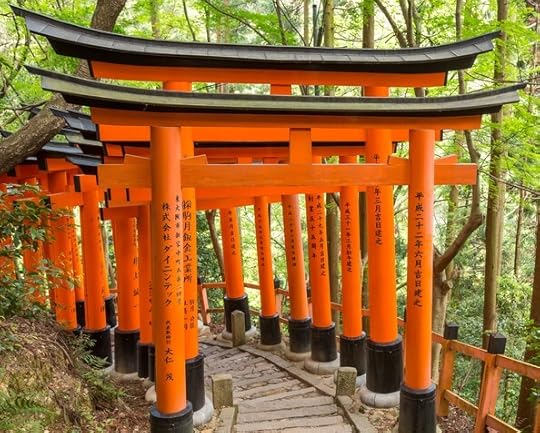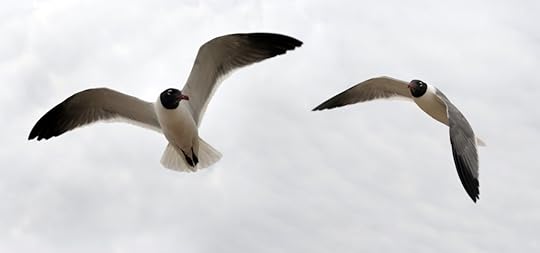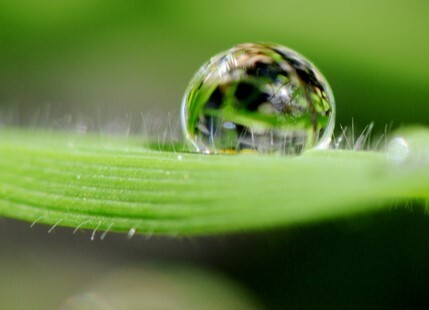The Fundamental Point and Make the Dark Night Shine
Originally penned in 1233 and revised in 1252 by Eihei Dōgen, The Genjō Kōan: Actualizing the Fundamental Point is considered one of the founding documents of Japanese Zen Buddhism. Written as a prose poem, Dōgen´s words are Zen itself, moving, paradoxical, enlightening and living. For almost one thousand years, Zen practitioners and scholars have written about, debated and explicated the meaning of this relatively short text. To this venerable list, I would now like to add my novel, Make the Dark Night Shine.
I realize this is an audacious statement that might offend scholars that have spent lifetimes studying and analyzing Dōgen´s words. How can a modern novel that is a love letter from a father to the daughter he never met possible be related to the Genjō Kōan? However, Dōgen`s words are not just for the scholars but all of us.
 Photo 151323362 © Marcel Van Den Bos | Dreamstime.com
Photo 151323362 © Marcel Van Den Bos | Dreamstime.com“That myriad dharmas come forth and illuminate the self is enlightenment.”
After doing a number of readings and talks about the novel at Zen Centers, I came to realize one can look at the novel as yet another interpretation this line from the Kōan. There are unlimited ways of becoming aware and awakened in our lives and one of my goals in writing Make the Dark Night Shine was to make people curious enough about Zen that they would seek more knowledge. And for current and future practitioners, I hope they find the novel another dharma gate in awakening.
Most often, Zen students read the Kōan from a perspective of what does it tell us of Zen. However, for me its importance has always been what does it tell us about living this very life through our own body and mind. Just as we create a story about what we call our lives, a novel is another way of exploring a life, in this case that of Kenzo, a Japanese diplomat turned Zen priest, who discovers many years after the fact that he has a daughter living in NY.
Knowing and not-knowing infuse the novel, as it does in each of our lives. Life is a very messy affair. Whether it is long or short, so many things happen over a lifetime. Minute by minute, second by second, experiences come and go, and our body changes. Our interactions with our physical environment, with other people and with our thoughts all are non-stop. While we have a notion that meditation and other mindfulness practices help us slow down, that is not what they are meant to do. They can only allow us to perceive differently, notice the things we might not notice or want to notice, endure things we might choose to ignore or engage with things with which we might not normally engage.
Just as our life is in motion, Dōgen´s depictions of the natural world in the Genjō Kōan are in constant movement.

“A fish swims in the ocean, and no matter how far it swims there is no end to the water. A bird flies in the sky, and no matter how far it flies there is no end to the sky… When their activity is large their field is large. When their need is small their field is small.”
My novel explores the small and large fields of life. Although it focuses on the period between the two world wars for the characters, the larger world of history, symbolized by Constantinople and other ancient cities around the world, the arts, religion and the movement of people set the scene. Human-created world events, such as wars, cities being built and destroyed and natural ones like earthquakes, fires or pandemics shake up the character´s lives. And they, as do we, search for some meaning to this movement.
 Photo 188726764 © Madelein Wolfaardt | Dreamstime.com
Photo 188726764 © Madelein Wolfaardt | Dreamstime.comYet is the small field of home, family, connections to others and our daily practices that provide the details of life. For fish and birds (and humans,) the essence of life is the interaction with their distinct environments. We are observers to the intricacies of the daily lives of Kenzo, Mitsu, Elisa and Gül, their relations with each other, and their connection to the illusive concept of home.
Kenzo may become a Zen priest but Dōgen´s words pop out of a sea captain, “How does the wind permeate everywhere?”; Elisa, Kenzo´s consort, “Can bird distinguish where they are in the sky? Do the measure distances or do they simply exist in the spacious air?”; Kenzo´s grandmother urges him to “Let go of your comparisons”; and most interactions with Mitsu, Kenzo´s same-sex partner are reminders to be aware of the moment and be present even in sickness and death.
“ When you ride in a boat and watch the shore, you might assume that the shore is moving. But when you keep your eyes closely on the boat, you can see that the boat moves.”
“When you sail out in a boat to the middle of an ocean where no land is in sight, and view the four directions, the ocean looks circular, and does not look any other way. But the ocean is neither round nor square; its features are infinite in variety. It is like a palace. It is like a jewel. It only looks circular as far as you can see at that time. All things are like this.”
For Dōgen, the ocean and water are metaphors for the ever-encompassing presence of Buddha-nature. Based on his writings, Dōgen´s own perilous journey across the sea to China and back appeared to be a life-changing event. As a person who had lived his life looking out on the ocean, all of his ideas of being a land-based person were challenged when confronted with a new viewpoints from the middle of the vast sea. Set in the 1920s and 30s before air travel was common, our world wanderers escape war and dire situations by steamships, start and end adventures on the water, and look out to sea from their lives on the land. Like Dōgen, the characters comment on the view from the sea compared to the view from the land, the nature of water and fish, the passage of time, the light of the moon reflecting on the water, the loneliness and the great expanse of the oceans. Kenzo even conducts a sesshin, full-day meditation sessions, on a steamship, using the water to guide his worrying thoughts.
“When you see forms or hear sounds, fully engaging body-and-mind, you intuit dharmas intimately.”
Such is the path for Kenzo. On his first day in Constantinople, he is surprised and moved by the beauty and enchantment of the muezzin call to daily prayer. He feels the call in his body and is astonished as the men on the street drop to their knees in response. Later he encounters the Sufi mystics whirling around themselves in their attempt to liberate themselves from their body and in doing so to bring peace to all. The wind on the top of the Eifel Tower even brings a sense of greater connection to him. When a series of unexpected events dislodges Kenzo from his planned life, he is invited to sit and work with a Zen priest and his path in Way begins in earnest.
At Eiheiji Zen monastery, the home of Soto Zen founded Dōgen, Kenzo meets the Genjō Kōan for the first time.
“To study the buddha way is to study the self. To study the self is to forget the self. To forget the self is to be actualized by myriad things. When actualized by myriad things, your body and mind as well as the bodies and minds of others drop away. No trace of realization remains, and this no-trace continues endlessly.”
His teacher uses the poetry of this phrase to talk to Kenzo about his relationships with others, Zazen and how to understand the workings of his mind. The body practices that he saw earlier in Constantinople prepare him for sitting, letting the mind drop off and finally name the ungraspable feeling he has had for so long.
The challenge to Kenzo and ourselves is to maintain this awareness through lives that experience love and joy, as well as loss and death, sickness, violence, racism, sexism, homophobia and the innumerable other harms that humans bring on each other.
Dōgen calls us to be in the world, to see its diversity and to experience its conditions.
“Though there are many features in the dusty world and the world beyond conditions, you see and understand only what your eye of practice can reach. In order to learn the nature of the myriad things, you must know that although they may look round or square, the other features of oceans and mountains are infinite in variety; whole worlds are there. It is so not only around you, but also directly beneath your feet, or in a drop of water.”
Our own calling requires us to respond to those conditions in the ways we can. This is the core of the novel. How do we take hold of the life we have, the life we were born into? Can we approach life with equanimity again and again? Can we recognize the harm we cause to ourselves and others as easily as we recognize the joy we bring? Kenzo, who uncovers the secrets of his family, a man trying to do the right thing, trying to be model to others, must constantly face the reality of not having the power to change the conditions in which he was born or the ability to change other people because he wants them to change. This quandary is most explicit in his vow to end all war, which remains strong even after he is arrested and the bombs from the German Blitz on London are falling on the city. And with all of this knowledge, he yearns to connect with Nina and leaves his writings to her with scant hope that she will see them.
 Photo 96449540 © Sitriel | Dreamstime.com
Photo 96449540 © Sitriel | Dreamstime.com“The wind of the Buddha’s house brings forth the gold of the earth and makes fragrant the cream of the long river.”
This last line of the Genjō Kōan is one of the most evocative and enigmatic. The river is our life, beginning its birth and constant renewal in the far past in a place we cannot remember. A river ends by joining the immensity of the seas, its water intermingling with the waters from every other source on earth. Just as a river changes its course due to subtle influences over time or due to massive upheavals of the earth or weather, so do we.
The life-path for Kenzo, his daughter Nina and all of the characters meander like the long river, coming from a source of ancestors, history and environment we never knew and going to an ocean that is undefinable in its great size and encompasses our being. The river banks contain our life story, yet routinely that story is interrupted as the river overflows and pushes against self- or society-imposed limitations. In the aftermath, the flow of our life is forever altered, our souls are fertilized by the earth supporting us and over time new pathways emerge to focus us. With the winds of Buddhism on our back we are pushed forward to drop fear and to experience the transcendence and richness of the inter-connection with all.
 Photo 194821297 © Marco Montalti | Dreamstime.com
Photo 194821297 © Marco Montalti | Dreamstime.comKintsugi is the Japanese art of fixing broken pottery using a gold sealant to repair the cracks. The end result is not to hide the cracks, but to accentuate them, to imbue the pottery with a new sense of beauty and utility. Applying the idea of Kintsugi to Dōgen´s words, the gold from the earth reveals the thick creamy richness of life´s experience and imperfections.
 Photo 9179103 © Andibyte | Dreamstime.com
Photo 9179103 © Andibyte | Dreamstime.com“The whole moon and the entire sky are reflected in dewdrops on the grass.”
Our family histories, the times we live in, the places we live, the work we do, the loves we had and lost, the joys and horrors that we have witnessed, our doubts, the things we are sure about, the moment-to-moment state of our health are reflected in our facial expressions, how we hold our shoulders, how we walk and sit, how our skin wrinkles. Our own Kintsugi-lined body is the body of humanity and our unique individual imperfections are merely reflections of all human imperfection. Just as our own life stories, written tales like Make the Dark Night Shine, and the Genjō Kōan are indivisible from each other.
—
All quotes come the Robert Aitkin and Kazuaki Tanahashi translation of the Genjō Kōan.
Make the Dark Night Shine is available worldwide at your local bookseller or on-line. In the US, you can support local independent booksellers by buying online here.



